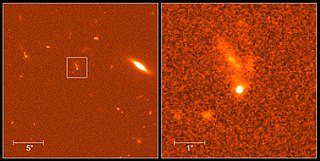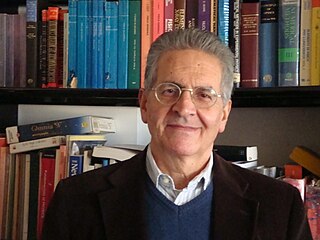Related Research Articles

In gamma-ray astronomy, gamma-ray bursts (GRBs) are immensely energetic explosions that have been observed in distant galaxies. They are the most energetic and luminous electromagnetic events since the Big Bang. Bursts can last from ten milliseconds to several hours. After an initial flash of gamma rays, a longer-lived "afterglow" is usually emitted at longer wavelengths.

BeppoSAX was an Italian–Dutch satellite for X-ray astronomy which played a crucial role in resolving the origin of gamma-ray bursts (GRBs), the most energetic events known in the universe. It was the first X-ray mission capable of simultaneously observing targets over more than 3 decades of energy, from 0.1 to 300 kiloelectronvolts (keV) with relatively large area, good energy resolution and imaging capabilities. BeppoSAX was a major programme of the Italian Space Agency (ASI) with the participation of the Netherlands Agency for Aerospace Programmes (NIVR). The prime contractor for the space segment was Alenia while Nuova Telespazio led the development of the ground segment. Most of the scientific instruments were developed by the Italian National Research Council (CNR) while the Wide Field Cameras were developed by the Netherlands Institute for Space Research (SRON) and the LECS was developed by the astrophysics division of the European Space Agency's ESTEC facility.

The Compton Gamma Ray Observatory (CGRO) was a space observatory detecting photons with energies from 20 keV to 30 GeV, in Earth orbit from 1991 to 2000. The observatory featured four main telescopes in one spacecraft, covering X-rays and gamma rays, including various specialized sub-instruments and detectors. Following 14 years of effort, the observatory was launched from Space Shuttle Atlantis during STS-37 on April 5, 1991, and operated until its deorbit on June 4, 2000. It was deployed in low Earth orbit at 450 km (280 mi) to avoid the Van Allen radiation belt. It was the heaviest astrophysical payload ever flown at that time at 17,000 kilograms (37,000 lb).

Neil Gehrels Swift Observatory, previously called the Swift Gamma-Ray Burst Explorer, is a NASA three-telescope space observatory for studying gamma-ray bursts (GRBs) and monitoring the afterglow in X-ray, and UV/Visible light at the location of a burst. It was launched on 20 November 2004, aboard a Delta II launch vehicle. Headed by principal investigator Neil Gehrels, at Goddard Space Flight Center (GSFC), the mission was developed in a joint partnership between GSFC and an international consortium from the United States, United Kingdom, and Italy. The mission is operated by Pennsylvania State University as part of NASA's Medium Explorer program (MIDEX).

GRB 970228 was the first gamma-ray burst (GRB) for which an afterglow was observed. It was detected on 28 February 1997 at 02:58 UTC. Since 1993, physicists had predicted GRBs to be followed by a lower-energy afterglow, but until this event, GRBs had only been observed in highly luminous bursts of high-energy gamma rays ; this resulted in large positional uncertainties which left their nature very unclear.
GRB 971214 is a gamma-ray burst observed in 1997. It originated 12 billion light years away. For a brief period this was thought by some researchers to have been the most energetic event observed in the universe, but this was before it was established that gamma-ray bursts are beamed towards the Earth. Thus, at the time of the discovery it was hypothesized by G. Djorgovski and his collaborators that the outburst put out more energy than several hundred typical supernovae, or the energy our galaxy puts out over a couple of centuries. However, a couple of years later it was realized that this was an upper limit as it is likely that the burst was directed towards Earth. If the jet had an opening angle of only a few degrees, the burst energy could have been thousands of times lower. The X-ray afterglow and the host galaxy of the GRB have also been observed, using BeppoSAX and Keck II respectively. The host galaxy lies at redshift z=3.4.
Dale A. Frail is a Canadian astronomer working at the National Radio Astronomy Observatory (NRAO) in Socorro, New Mexico.

Cornelis A. "Neil" Gehrels was an American astrophysicist specializing in the field of gamma-ray astronomy. He was Chief of the Astroparticle Physics Laboratory at NASA's Goddard Space Flight Center (GSFC) from 1995 until his death, and was best known for his work developing the field from early balloon instruments to today's space observatories such as the NASA Swift mission, for which he was the Principal investigator. He was leading the WFIRST wide-field infrared telescope forward toward a launch in the mid-2020s. He was a member of the National Academy of Sciences and the American Academy of Arts and Sciences.

GRB 080319B was a gamma-ray burst (GRB) detected by the Swift satellite at 06:12 UTC on March 19, 2008. The burst set a new record for the farthest object that was observable with the naked eye: it had a peak visual apparent magnitude of 5.7 and remained visible to human eyes for approximately 30 seconds. The magnitude was brighter than 9.0 for approximately 60 seconds. If viewed from 1 AU away, it would have had a peak apparent magnitude of −67.57.

GRB 970508 was a gamma-ray burst (GRB) detected on May 8, 1997, at 21:42 UTC; it is historically important as the second GRB with a detected afterglow at other wavelengths, the first to have a direct redshift measurement of the afterglow, and the first to be detected at radio wavelengths.
The history of gamma-ray began with the serendipitous detection of a gamma-ray burst (GRB) on July 2, 1967, by the U.S. Vela satellites. After these satellites detected fifteen other GRBs, Ray Klebesadel of the Los Alamos National Laboratory published the first paper on the subject, Observations of Gamma-Ray Bursts of Cosmic Origin. As more and more research was done on these mysterious events, hundreds of models were developed in an attempt to explain their origins.

GRB 090423 was a gamma-ray burst (GRB) detected by the Swift Gamma-Ray Burst Mission on April 23, 2009 at 07:55:19 UTC whose afterglow was detected in the infrared and enabled astronomers to determine that its redshift is z = 8.2, which makes it one of the most distant objects detected to date with a spectroscopic redshift.

GRB 990123 is a gamma-ray burst which was detected on January 23, 1999. It was the first GRB for which a simultaneous optical flash was detected. Astronomers first managed to obtain a visible-light image of a GRB as it occurred on January 23, 1999, using the ROTSE-I telescope in Los Alamos, New Mexico. The ROTSE-I was operated by a team under Dr. Carl W. Akerlof of the University of Michigan and included members from Los Alamos National Laboratory and Lawrence Livermore National Laboratory. The robotic telescope was fully automated, responding to signals from NASA's BATSE instrument aboard the Compton Gamma Ray Observatory within seconds, without human intervention. In the dark hours of the morning of January 23, 1999, the Compton satellite recorded a gamma-ray burst that lasted for about a minute and a half. There was a peak of gamma and X-ray emission 25 seconds after the event was first detected, followed by a somewhat smaller peak 40 seconds after the beginning of the event. The emission then fizzled out in a series of small peaks over the next 50 seconds, and eight minutes after the event had faded to a hundredth of its maximum brightness. The burst was so strong that it ranked in the top 2% of all bursts detected.
X-ray emission occurs from many celestial objects. These emissions can have a pattern, occur intermittently, or as a transient astronomical event. In X-ray astronomy many sources have been discovered by placing an X-ray detector above the Earth's atmosphere. Often, the first X-ray source discovered in many constellations is an X-ray transient. These objects show changing levels of X-ray emission. NRL astronomer Dr. Joseph Lazio stated: " ... the sky is known to be full of transient objects emitting at X- and gamma-ray wavelengths, ...". There are a growing number of recurrent X-ray transients. In the sense of traveling as a transient, the only stellar X-ray source that does not belong to a constellation is the Sun. As seen from Earth, the Sun moves from west to east along the ecliptic, passing over the course of one year through the twelve constellations of the Zodiac, and Ophiuchus.
GRB 011211 was a gamma-ray burst (GRB) detected on December 11, 2001. A gamma-ray burst is a highly luminous flash associated with an explosion in a distant galaxy and producing gamma rays, the most energetic form of electromagnetic radiation, and often followed by a longer-lived "afterglow" emitted at longer wavelengths.
GRB 031203 was a gamma-ray burst (GRB) detected on December 3, 2003. A gamma-ray burst is a highly luminous flash associated with an explosion in a distant galaxy and producing gamma rays, the most energetic form of electromagnetic radiation, and often followed by a longer-lived "afterglow" emitted at longer wavelengths.
GRB 030329 was a gamma-ray burst (GRB) that was detected on 29 March 2003 at 11:37 UTC. A gamma-ray burst is a highly luminous flash associated with an explosion in a distant galaxy and producing gamma rays, the most energetic form of electromagnetic radiation, and often followed by a longer-lived "afterglow" emitted at longer wavelengths. GRB 030329 was the first burst whose afterglow definitively exhibited characteristics of a supernova, confirming the existence of a relationship between the two phenomena.
GRB 070714B was a gamma-ray burst (GRB) that was detected on 14 July 2007 at 04:59 UTC. A gamma-ray burst is a highly luminous flash associated with an explosion in a distant galaxy and producing gamma rays, the most energetic form of electromagnetic radiation, and often followed by a longer-lived "afterglow" emitted at longer wavelengths.
The Space Variable Objects Monitor (SVOM) is a planned small X-ray telescope satellite under development by China National Space Administration (CNSA), Chinese Academy of Sciences (CAS) and the French Space Agency (CNES), to be launched in mid-2023.

Filippo Frontera is an Italian astrophysicist and professor, who deals with astronomical investigations on celestial gamma-rays.
References
- ↑ "Phoswich "phosphor sandwich" detector description from Saint Gobain Crystals". Archived from the original on 2013-01-04. Retrieved 2012-06-14.
- ↑ message of GRB 970228 to the IAU by Costa and others. Costa, Frontera, et al. Discovery of an X-ray afterglow associated with the γ-ray burst of 28 February 1997, Nature, Vol. 387, 1997, pp.783–785, Arxiv
- ↑ Daniel Reichert The redshift of GRB 970580, Astrophysical Journal Letters, Volume 495, 1997, pp. L99-L101
- ↑ "Costa's body of work" (Web page with links to papers and citations). Google Scholar. Retrieved 2012-06-15.